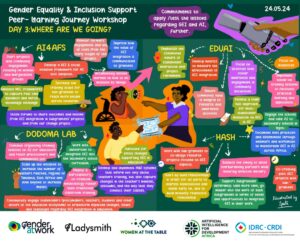Gender at Work India prepared a report on the status of Gender Equality in the Non-profit Sector in India. This report examines the Status of gender equality in the non-profit sector in India. The report sought to identify key challenges, trends and good practices in order to determine the most innovative practices being adopted to promote gender equality today. The underlying assumption among non-profits that they operate on values like social justice and human rights and are thus inherently equal in their workplace practices. Our study has not only dispelled this myth, but has attempted to draw the attention of non-profits to this discrepancy. This report highlighted a number of strategies that organisations in the non-profit sector could adopt to create a more gender equal workplace:
Institutionalize Gender Equality in Workplace Culture Sensitization broader: Gender sensitization workshops, particularly on sexual harassment, are mandatory by law. Based on our study, many organisations were unaware of the legal dimension as well as the importance of institutionalising workshops to advance gender equality. It is crucial that organisations hold these workshops regularly in order to understand gender equality in practice.
Cultivate and Strengthen Women’s Leadership: Leadership is crucial as it sets an example. Most organisations have greater gender diversity due to informed and effective leadership. A focus on building women’s leadership goes a long way. The non-profit sector does not appear to be generating a pipeline for women leaders. Strengthening secondary leadership among women should be made a priority for women’s leadership to grow within this sector. Women leaders are often role models for women. Organisations should prioritise leadership for women to create a gender balance in the workforce at senior levels of management.
Mentorship: Mentorship as a formalised process caters to specific challenges for both women and men, particularly in terms of career progression and the dual responsibilities for women in the household. It is an effective way to address the unique challenges that women face and engage men in household work.
Have people-focused strategy for your organization’s growth: It is very important to create and strengthen a Human Resources unit in an organisation. The absence of a Human Resources Unit in most non-profits appears to blur professional boundaries. By instituting exit interviews, for example, organisations have an opportunity to reflect about their internal practices varying from how recruitment is undertaken and the importance of career susscession. By focusing on one’s own staff’s well-being, organisations gain tremendously on the work-life balance front. This is particularly because organisations tend to focus on stregnthening the external capacity of communities or CBOs that CSOs they work with while often ignoring their own capacities.
Engage Men to Transform Workplace Cultures: It is important to reflect about the masculine nature of the workplace and notions of productivity and efficiency in today’s technologically progressive world. Men need to recognise and address the challenges that women face in the workplace in order to transform carework practices and household responsibilities.
Provide Space for Reflection: When organisations encourage their employees to freely speak about discrimination by providing space for reflection, they foster an environment that is conducive for change. There is little space provided in civil society organisations in India and globally for people to come together to deliberate upon issues that are breaking socio-cultural norms and going against the grain. By creating a safe space for discussion, organisations can support their employees in unique ways.
Build Tools for Data Collection: With greater access to data regarding perceptions of gender equality in the workplace, better practices can be designed to facilitate diversity and inclusion. It would be good for oraganisatons to undertake self-assessments using a diagnostic tool, to ascertain the extent to which they are gender diverse.
Create Strong Accountability Measures With Budgetary Allocation: In order to measure the impact of measures adopted for gender equality, it is important to create an accountable system with a special budget to drive home the point clearly. Most organisations in the non-profit sector are donor driven. Given the funding constraint that plagues donor-driven organisations, special budgets for genders sensitization policies should be included within proposals for donors to examine.
About the Authors
The report was developed by a team from Gender at Work consisting of Sudarsana Kundu, Country Director – Gender at Work India and Swaha Katyayini Ramnath. Institute of Social Studies Trust published the report with support from the Heinrich Böll Stiftung, India. Click here to access the report. You can also contact Sudarsana
at skundugenderatwork@gmail.com
Gender at Work is an international collaborative that helps organisations to build cultures of equality and social justice, with a focus on gender equality. It was founded in 2001 by AWID, CIVICUS, UN Women and Women’s Learning Partnership (WLP) and was established as a non- profit in 2003. In 1999, Aruna Rao, David Kelleher and Rieky Stuart wrote Gender at Work: Organisational Change for Equality, a book that laid the seeds for this organization.
View the article here.



